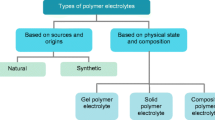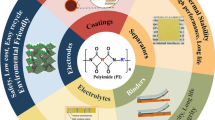Abstract
The ionic conduction, charge carrier relaxation and transport properties of a cost-effective and environment friendly chitosan acetate (CA) – lithium perchlorate (LiClO4) solid biopolymer electrolytes (SBE) are reported here. The highest ionic conductivity of 1.33 \(\times\) 10–5 S/cm is obtained for the SBE at 44.44 wt. % LiClO4 concentration at room temperature. Mobility of the free carrier ions is significantly increased by two orders of magnitude with enhanced charge carrier hopping rate due to the inclusion of salt. The frequency dependence of the conductivity spectra are analyzed based on a model considering the fractal nature of the electrode-SBE interface. A remarkable improvement in dielectric constant (from ~ 102 to ~ 105) is observed with increase in salt concentrations. The electric modulus spectra are analyzed using Havriliak–Negami equation, inferring a non-Debye type relaxation process. The relaxation function of the SBE is modeled successfully using non-exponential KWW function. It is observed that the value of the stretched exponent is much less than unity, suggesting that the charge carrier relaxation behavior is highly non-exponential in the SBE. FTIR spectroscopy confirms more lithium ion coordination with the polar amide groups of biopolymer, resulting in ionic transport through the biopolymer chains.










Similar content being viewed by others
References
Singh R, Bhattacharya B, Rhee HW, Singh PK (2014) New biodegradable polymer electrolyte for dye sensitized solar cell. Int J Electrochem Sci 9:2620–2630
Liang GJ, Zhong ZC, Xu J, Zhang ZC, Chen MH, Li ZF (2012) Quasi-solid state dye sensitized solar cells based on the novel cross linked polymer electrolyte. Acta Phys Chim Sin 28:2852–2860
Polo Fonseca C, Neves S (2006) Electrochemical properties of a biodegradable polymer electrolyte applied to a rechargeable lithium battery. J Power Sources 159:712–716
Polu AR, Rhee H-W, Kim DK (2015) New solid polymer electrolytes (PEO20–LiTDI–SN) for lithium batteries: structural, thermal and ionic conductivity studies. J Mater Sci: Mater Electron 26:8548–8554
Sudhakar YN, Selvakumar M (2012) Lithium perchlorate doped plasticized chitosan and starch blend as biodegradable polymer electrolyte for supercapacitors. Electrochim Acta 78:398–405
Sudhakar YN, Selvakumar M, Bhat DK (2013) LiClO4-doped plasticized chitosan and poly(ethylene glycol) blend as biodegradable polymer electrolyte for supercapacitors. Ionics 19:277–285
Tiwari T, Srivastava N, Srivastava PC (2011) Electrical transport study of potato starch-based electrolyte system. Ionics 17:335–360
Tiwari T, Pandey K, Srivastava N, Srivastava PC (2011) Effect of glutaraldehyde on electrical properties of arrowroot starch + NaI electrolyte system. J Appl Polym Sci 121:1–7
Azli AA, Manan NSA, Kadir MFZ (2017) The development of Li+ conducting polymer electrolyte based on potato starch/graphene oxide blend. Ionics 23:411–425
Buraidah MH, Teo LP, Majid SR, Arof AK (2009) Ionic conductivity by correlated barrier hopping in NH4I doped chitosan solid electrolyte. Phys B 404:1373–1379
Fadzallah IA, Majid SR, Careem MA, Arof AK (2014) Relaxation process in chitosan-oxalic acid solid polymer electrolytes. Ionics 20:969–975
Kumar MNVR (2000) A review of chitin and chitosan applications. React Funct Polym 46:1–27
García MA, Pinotti A, Martino M, Zaritzky N (2009) Electrically treated composite films based on chitosan and methylcellulose blends. Food Hydrocoll 23:722–728
MacCallum JR, Smith MJ, Vincent CA (1984) The effects of radiation-induced crosslinking on the conductance of LiClO4.PEO electrolytes. Solid State Ion 11:307–312
Abdullah OG, Aziz SB, Saber DR, Abdullah RM, Hanna RR, Saeed SR (2017) Characterization of polyvinyl alcohol film doped with sodium molybdate as solid polymer electrolytes. J Mater Sci: Mater Electron 28:8928–8936
Liu J, Khanam Z, Muchakayala R, Song S (2020) Fabrication and characterization of Zn-ion-conducting solid polymer electrolyte flms based on PVdF-HFP/Zn(Tf)2 complex system. J Mater Sci: Mater Electron 31:6160–6173
Dyre JC, Maass P, Roling B, Sidebottom DL (2009) Fundamental Questions Relating to Ion Conduction in Disordered Solids. Rep Prog Phys 72:046501
Wang B, Li S, Wang S (1997) Correlation between the segmental motion and ionic conductivity of poly (ether urethane)-LiClO4 complex studied by positron spectroscopy. Phys Rev B 56:11503–11507
Kremer F (2003) Broadband Dielectric Spectroscopy. Springer, Berlin
Buraidah MH, Shah S, Teo LP, Chowdhury FI, Careem MA, Albinsson I, Mellander B-E, Arof AK (2017) High efficient dye sensitized solar cells using phthaloylchitosan based gel polymer electrolytes. Electrochim Acta 245:846–853
Bandara TMWJ, Dissanayake MAKL, Albinsson I, Mellander B-E (2011) Mobile charge carrier concentration and mobility of a polymer electrolyte containing PEO and Pr4N+I− using electrical and dielectric measurements. Solid State Ion 189:63–68
Arof AK, Amirudin S, Yusof SZ, Noor IM (2014) A method based on impedance spectroscopy to determine transport properties of polymer electrolytes. Phys Chem Chem Phys 16:1856–1867
Almond DP, Duncan GK, West AR (1983) The determination of hopping rates and carrier concentrations in ionic conductors by a new analysis of ac conductivity. Solid State Ion 8:159
Almond DP, West AR (1983) Impedance and modulus spectroscopy of “real” dispersive conductors. Solid State Ion 11:57
Dam T, Jena SS, Pradhan DK (2016) The ionic transport mechanism and coupling between the ion conduction and segmental relaxation processes of PEO20-LiCF3SO3 based ion conducting polymer clay composites. Phys Chem Chem Phys 18:19955–19965
Funke K (1993) Jump relaxation in solid electrolytes. Prog Solid State Chem 22:111
Khamzin AA, Popov II, Nigmatullin RR (2014) Correction of the power law of ac conductivity in ion-conducting materials due to the electrode polarization effect. Phys Rev E 89:032303
Pal P, Ghosh A (2015) Dynamics and relaxation of charge carriers in poly (methylmethacrylate)-based polymer electrolytes embedded with ionic liquid. Phys Rev E 92:062603
Dyre JC (1988) The random free-energy barrier model for ac conduction in disordered solids. J Appl Phys 64:2456
Choudhary S, Sengwa RJ (2017) Effects of different inorganic anoparticles on the structural, dielectric and ion transportation properties of polymers blend based nanocomposite solid polymer electrolytes. Electrochim Acta 247:924–941
Baskaram R, Selvasekarapandian S, Hirankumar G, Bhuvaneswari MS (2004) Vibrational ac impedance and dielectric spectroscopic studies of poly (vinylacetate)–N, N–dimethylformamide–LiClO4 polymer gel electrolytes. J Power Source 134:235
Dygas JR (2005) Dielectric function of ionic conductors studied by impedance spectroscopy. Solid State Ion 176:2065
Havriliak S, Negami S (1967) A complex plane representation of dielectric and mechanical relaxation processes in some polymers. Polymer 8:161
Howell FS, Bose RA, Macedo PB, Moynihan CT (1974) Electrical relaxation in a glass-forming molten salt. J Phys Chem 78:639
Jeevanandam P, Vasudevan S (1998) Alternating current conductivity and electrical conductivity relaxation in an intercalated polymer electrolyte. J Chem Phys 109:8102
Kohlrausch R (1847) Pogg Ann Phys (Leipzig) 12:393
Williams G, Watts DC (1970) Non-symmetrical dielectric relaxation behavior arising from a simple empirical decay function. Trans Faraday Soc 66:80
Tripathy SN, Wojnarowska Z, Knapik J, Shirota H, Biswas R, Paluch M (2015) Glass transition dynamics and conductivity scaling in ionic deep eutectic solvents: The case of (acetamide+ lithium nitrate/sodium thiocyanate) melts. J Chem Phys 142:184504
Ngai KL, Mundy JN, Jain H, Kanert O, Balzer-Jollenbeck G (1989) Correlation between the activation enthalpy and Kohlrausch exponent for ionic conductivity in alkali alumina germanate glasses. Phys Rev B 39:6169
Sidebottom DL, Roling B, Funke K (2000) Ionic conduction in solids: Comparing conductivity and modulus representations with regard to scaling properties. Phys Rev B 63:024301
Bandara TMWJ, Mellander B-E (2011) Ionic Liquids: Theory, Properties, New Approaches, ed. A Kokorin In Tech Janeza Trdine 9:383
Jacobs PWM, Lorimer JW, Russer A, Wasiucionek M (1989) Impedance studies on the system LiClO4-MEEP. J Power Sources 26:483
Druger SD, Ratner MA, Nitzan A (1985) Generalized hopping model for frequency-dependent transport in a dynamically disordered medium, with applications to polymer solid electrolytes. Phys Rev B 31:3939
Cui Z, Xiang Y, Si J, Yang M, Zhang Q, Zhang T (2008) Ionic interactions between sulfuric acid and chitosan membranes. Carbohydr Polym 73:111–116
Fadzallah IA, Majid SR, Careem MA, Arof AK (2014) A study on ionic interactions in chitosan- oxalic acid polymer electrolyte membranes. J Memb Sci 463:65–72
Baran EJ (2008) Spectroscopic investigation of the VO2+/chitosan interaction. Carbohydr Polym 74:704–706
Sim LH, Gan SN, Chan CH, Yahya R (2010) ATR-FTIR studies on ion interaction of lithium perchlorate in polyacrylate/poly(ethylene oxide) blends. Spectrochimica Acta Part A 76:287–292
Majumdar S, Sen P, Ray R (2019) Ionic interactions and transport properties in chitosan-starch based blend solid biopolymer electrolytes. Mater Today Proc 18:4913–4920
Osman Z, Arof AK (2003) FTIR studies of chitosan acetate based polymer electrolytes.Electrochimica Acta 48:993–999
Kadir MFZ, Aspanut Z, Majid SR, Arof AK (2011) FTIR studies of plasticized poly(vinyl alcohol)–chitosan blend doped with NH4NO3 polymer electrolyte membrane. Spectrochimica Acta Part A 78:1068–1074
Acknowledgement
Simantini Majumdar is thankful to DST PURSE – II (Ref. No. P-1/RS/18/17) for the research fellowship. Ruma Ray would like to thank DHESTBT, Government of West Bengal (Project No. 426(Sanc.)/ST/P/S&T/16G-16/2018) and JU-RUSA 2.0 Major Research Support (Project No. R-11/468/19) for providing the financial support. Authors wish to thank DST, Government of India, for developing instrument facility like LCR meter (Agilent 4294A-Precision Impedance Analyzer) under FIST programme at Department of Physics, Jadavpur University.
Author information
Authors and Affiliations
Corresponding author
Additional information
Publisher's Note
Springer Nature remains neutral with regard to jurisdictional claims in published maps and institutional affiliations.
Rights and permissions
About this article
Cite this article
Majumdar, S., Ray, R. Ionic conduction and charge carrier relaxation in chitosan acetate based solid biopolymer electrolyte embedded with LiClO4. J Polym Res 28, 157 (2021). https://doi.org/10.1007/s10965-021-02509-x
Received:
Accepted:
Published:
DOI: https://doi.org/10.1007/s10965-021-02509-x




